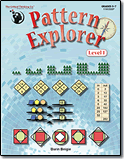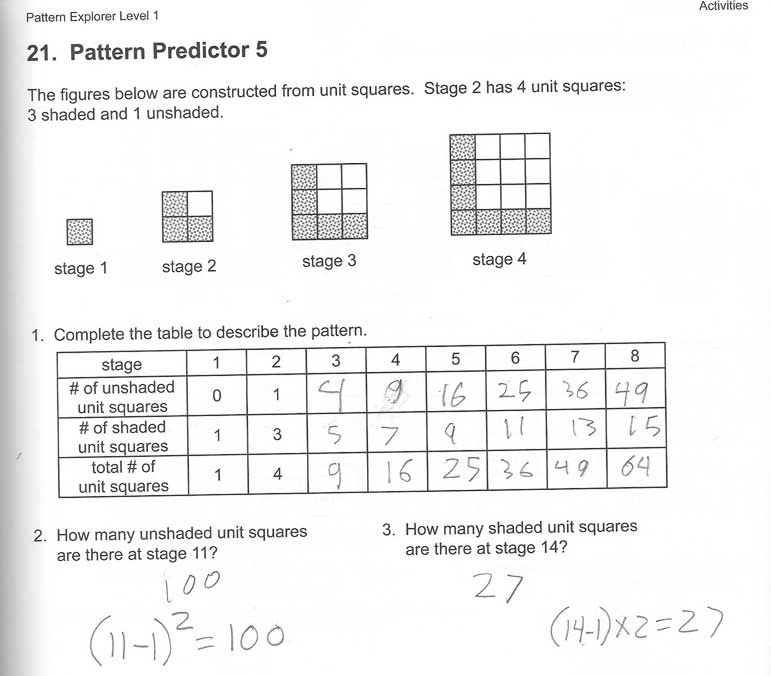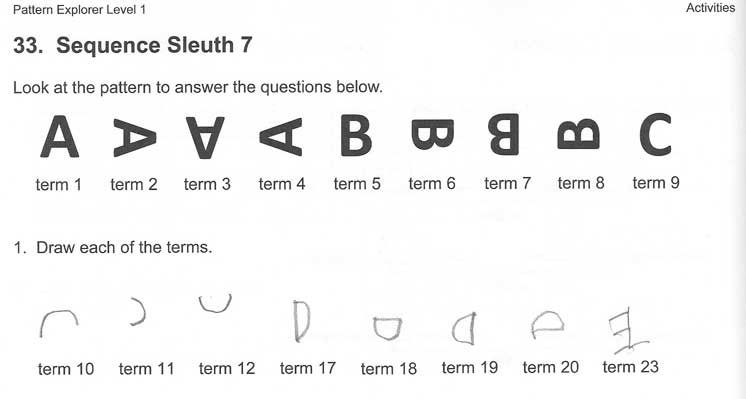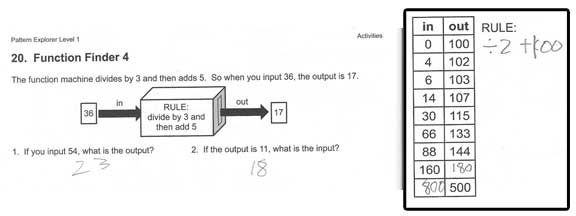
On my list of reasons why I homeschool you’ll find the following item: I want my son to be able to think for himself and to solve his own problems—I want him to recognize faulty logic in others and be able to defend his own decisions. My go-to vendor for accomplishing that goal has always been The Critical Thinking Co. They have over 200 titles covering all the core subjects: math, science, social studies, reading, and grammar. We’ve used their Reading Detective, Editor in Chief, Building Thinking Skills, You Decide and Balance Math. Now we’ve had the opportunity to use and review Pattern Explorer.
Why study patterns? Well, suppose you were hiking in the woods and you saw the following on the ground.

Would you assume that the pinecones just happened to fall from the tree and formed this arrow sign? NO! The fact that there is a pattern is a sign that intelligent life has passed by the spot before you. Perhaps it’s a message from a friend you’re trying to meet up with, or perhaps you left this message for yourself  so you could find your way OUT of the woods. We see patterns in the night sky—the constellations and the non-moving North Star help us navigate while the repeating phases of the moon help us track the passage of time. The planet Neptune was discovered when scientists recognized something out there was causing Uranus to deviate from its predicted pattern of orbiting the sun. All in all, I would say being able to recognized a pattern is fairly important.
so you could find your way OUT of the woods. We see patterns in the night sky—the constellations and the non-moving North Star help us navigate while the repeating phases of the moon help us track the passage of time. The planet Neptune was discovered when scientists recognized something out there was causing Uranus to deviate from its predicted pattern of orbiting the sun. All in all, I would say being able to recognized a pattern is fairly important.
In this case the patterns all fall in the area of math. Pattern Explorer is a softcover book of 92 pages (48 pages are puzzles and the remaining are hints and the answer key). The puzzles can be categorized as follows:
1. Pattern Predictor—These are usually graphic in nature, usually row and columns of shaded and unshaded shapes that grow in number at each stage. Sometimes there was a table to fill out to help Schnickelfritz recognize the growth pattern and then he would be asked questions about higher stages (where no graphic is provided).

2. Equality Explorer—These problems are like the one we solved in our review of Balance Math Teaches Algebra. At that time I had made laminated/magnetic shapes that we could actually manipulate from side to side. Now Fritz was able to work more abstractly with just the images on the page. Each virtual balance beam has shapes and numbers and the student must determine the value of each shape.

3. Sequence Sleuth—These problems are similar to Pattern Predictor in that they come as a series of terms or stages, but rather than growth, the patterns may involved orientation, passage of time (with clock faces), or alternating shading patterns.

4. Number Ninja—These problems took a variety of forms from filling in magic squares (where each row, column, and diagonal add up to the same number) or following a set order of operations and determining what the outcome would be for a given number.

5. Function Finder—These problems are sort of the inverse of Number Ninja. Here you are given the starting number and the output and it’s up to you to determine the operations (usually 1 or 2) that turn one into the other. At first they drew a machine giving us a sample, but later we just had tables of “what went in” and “what came out.”

We used the book as an “educational boredom buster.” If Schnickelfritz asked what he could do I’d say “Have you looked for any patterns lately? Let’s see how many puzzles you can crack in 15 minutes.” We also saved them for in between subject activities, especially after I’d been reading long passages, to wake up brain cells. Sometimes he took the book to his grandparents to work on instead of spending all his time on their high speed internet. Math is his strong suit so he didn’t have any problems, but if your child is struggling there are hints in the back of the book to get them on track for each puzzle.
I wouldn’t consider this book to be a stand on its own math curriculum, but rather a way to reinforce math you’ve already learned—adding, subtracting, multiplying, and dividing-- in a different (and I’d say fun) way. If you have to record hours and subjects for your state’s homeschooling laws you might want to call this logic. Our only disappointment was the book was too short—Schnickelfritz had worked through all the problems in less than three weeks.



No comments:
Post a Comment